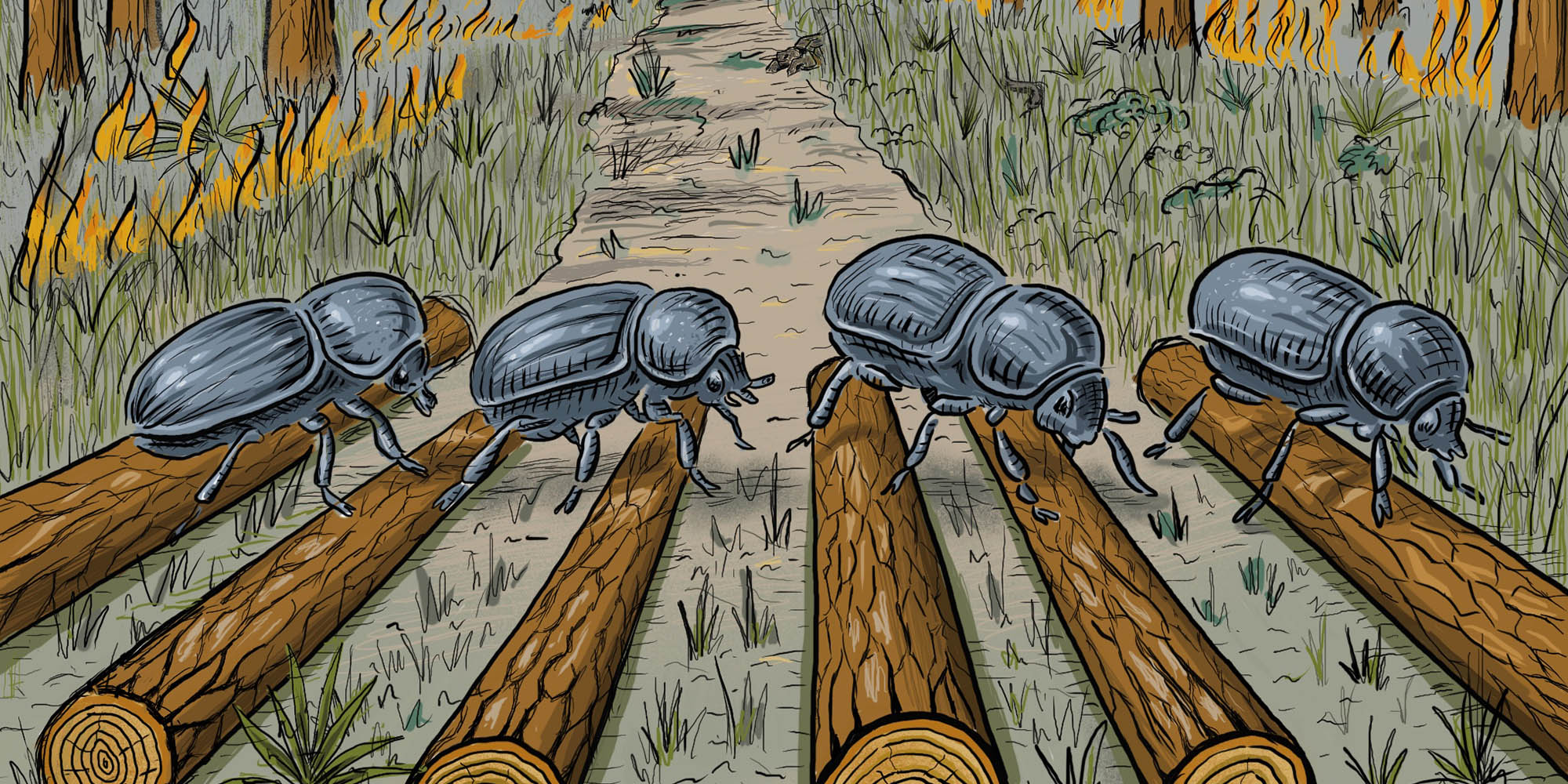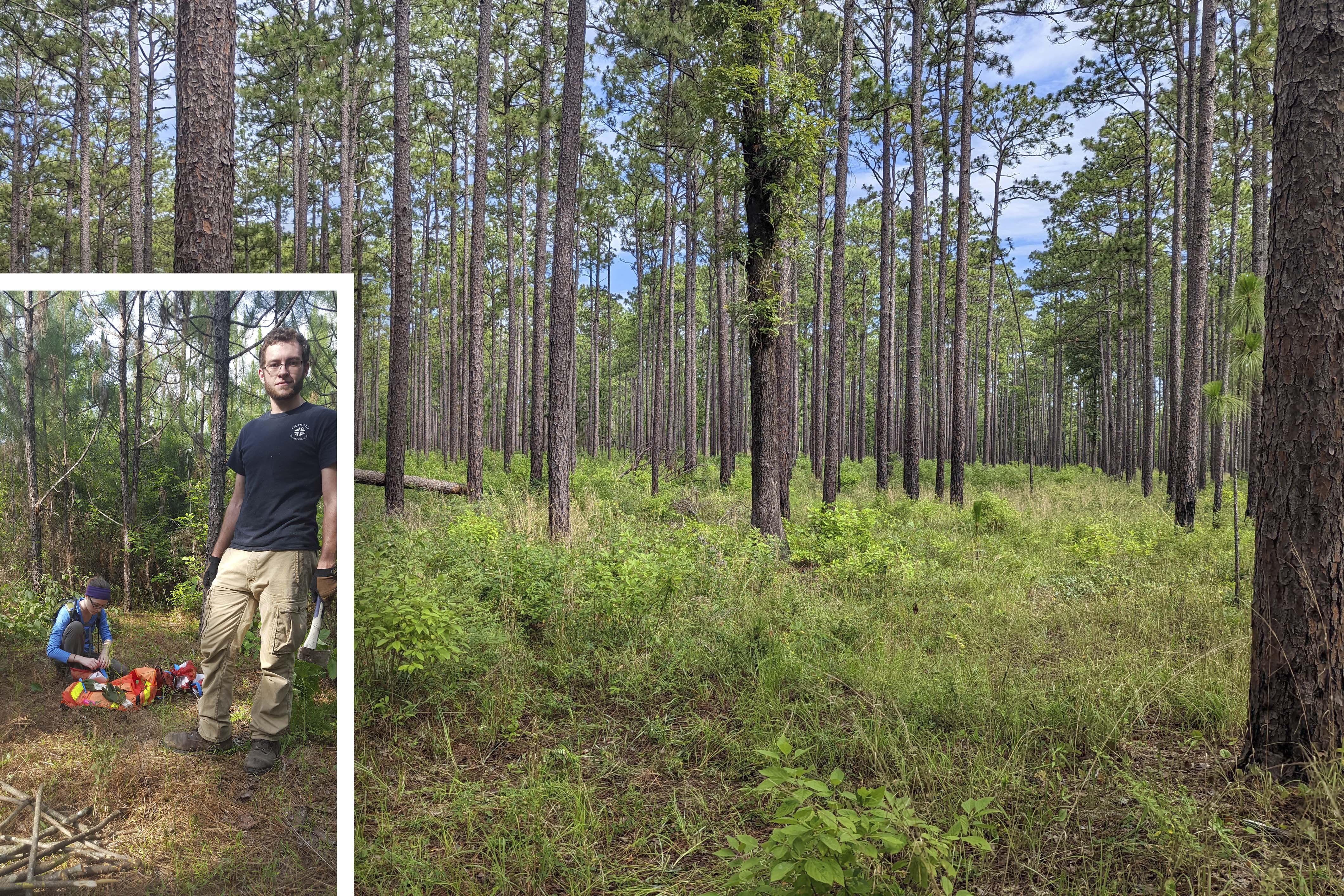Beetlemania
Prescribed fire—essential to longleaf pine conservation—attracts unwanted guests
By: Vanessa Beeson
Once stretching across more than 92 million acres of the Southeastern United States, longleaf pine forests were a defining feature of the American South. From Virginia through Florida and into Texas, these forests formed a fire-adapted ecosystem teeming with unique plant and animal life. Today, less than five million acres remain.
Efforts to restore this endangered ecosystem are gaining traction, and prescribed fire is one of the most important tools in the conservation toolkit. But as researchers at Mississippi State University have discovered, this solution comes with unexpected tradeoffs—including the rise of invasive beetle species that are reshaping the way these forests function.
Dr. John Riggins, a professor in Mississippi State University's Department of Agricultural Science and Plant Protection and an entomologist with the Mississippi Agricultural and Forestry Experiment Station, or MAFES, is leading a study that explores how fire, while essential to longleaf pine survival, also creates habitat disturbances that may benefit exotic ambrosia beetles.
"Longleaf pine forests are fire-dependent, endangered ecosystems with high biodiversity," Riggins explained. "Prescribed fire is critical for their health and regeneration, but it also opens the door for invasive species that thrive on disturbance."
To explore that connection, Riggins and his team, including research associate John Thomason, spent two years studying both native and exotic ambrosia beetle populations in mixed longleaf pine forests in Alabama. They compared beetle communities in recently burned and unburned sites and found a striking difference: in burned areas, two-thirds of the beetles collected were non-native. Overall species diversity was about evenly split between native and exotic, but the sheer abundance of non-native beetles in disturbed plots stood out.
The findings support a growing body of evidence suggesting that disturbances—from fire to logging to development—create opportunities for invasive species to take hold.
"Invasive insects are disproportionately attracted to disturbed areas," Riggins said.
"That could be a wildfire, a prescribed burn, or even construction. These disturbances create ecological niches—opportunities that allow non-native species to move in and gain a foothold."
While fire didn't harm the native beetle populations, which were adapted to fire-prone habitats, the exotic beetles surged in response to it. Riggins said their advantage lies in their ability to exploit stressed trees—those weakened by fire, drought, or nutrient deficiency.
And that's where things get even more complicated.
Ambrosia beetles are no ordinary wood borers. They rely on a unique symbiotic relationship with fungi, which they carry in specialized structures called mycangia. These fungi help them break down wood and serve as food for their larvae.
"This symbiosis is fascinating," Riggins said. "These beetles are widely regarded to be fungus farmers because they bore into the wood, plant the fungi, and then their larvae feed exclusively on the fungus. It's a completely different way of decomposing wood."
But when exotic beetles with unfamiliar fungal partners move in, they can disrupt the finely tuned balance of native forest ecosystems. Early research suggests these new species may be altering decomposition rates, shifting nutrient cycles, and even impacting carbon storage.
"These insects are fundamentally changing how decomposition works in these forests," Riggins said. "Nutrient cycling—the natural process that breaks down organic matter and returns it to the soil—may not function the same way when it's driven by non-native fungi."
That matters even more in longleaf pine forests, where the soils are often sandy and low in nutrients, like phosphorus and potassium. Longleaf pine trees are already adapted to these harsh conditions, but any disruption to nutrient availability could impact growth, regeneration, and overall ecosystem resilience.
"As drought becomes more common and trees are increasingly stressed, we need to understand how these beetles interact with that stress," Riggins said. "Their fungi might change the availability of nutrients, making it harder for longleaf pine to survive in marginal soils."
For Thomason, the project is more than academic. It's a chance to protect one of the South's most iconic and endangered landscapes.
"Longleaf pine forests are home to a lot of species you don't see anywhere else," he said.
"While we were in the field, we saw gopher tortoises, red-cockaded woodpeckers, and the black pine snake—all endangered species that depend on this ecosystem. Knowing that our work might help preserve that habitat is really meaningful."
The research also has important implications for early detection of new invasions. Longleaf pine forests, especially those located near trade hubs, may serve as natural monitoring stations for newly introduced insects.
"The longleaf stands that experience prescribed burns and other frequent disturbances and are also located near ports or high-trade activity areas might offer us an opportunity to monitor new invasive ambrosia beetles and other insects," Riggins said. "Sometimes it makes a big difference whether we discover new non-native species early or whether they've been here for 10 or 20 years and already have a foothold."
The ultimate challenge, he said, is managing the complex relationship between fire and forest health. Prescribed burns are essential for longleaf pine regeneration.
Prescribed fire also reduces competition from hardwoods and therefore maintains the savannah structure that is typical of longleaf pine forests and promotes the growth of native grasses and wildflowers. But, at the same time, it opens the door to species that don't belong.
"Like it or not, the exotic ambrosia beetles we found are here to stay," Riggins said. "We have to figure out how to manage their impact."
While fire remains a powerful ally in the fight to restore longleaf pine, it's clear that every intervention comes with tradeoffs. Managing those tradeoffs will be key to conserving these iconic Southern forests for generations to come.
"We're not saying 'stop burning'," Riggins said. "We're saying 'let's understand the consequences so we can manage them better."
This research is funded by the Mississippi Agricultural and Forestry Experiment Station.
Invasive insects are disproportionately attracted to disturbed areas. That could be a wildfire, a prescribed burn, or even construction. These disturbances create ecological niches—opportunities that allow non-native species to move in and gain a foothold.
Dr. John Riggins
Behind the Science

John Riggins
Professor
Education: B.S., Biology, M.S., Biotechnology, University of Nebraska at Kearney; Ph.D., Entomology, University of Arkansas Fayetteville
Years At MSU: 17
Focus: Forest health, sustainability, and resilience
Passion At Work: Protecting forest resources, working with students, and assisting landowners.


